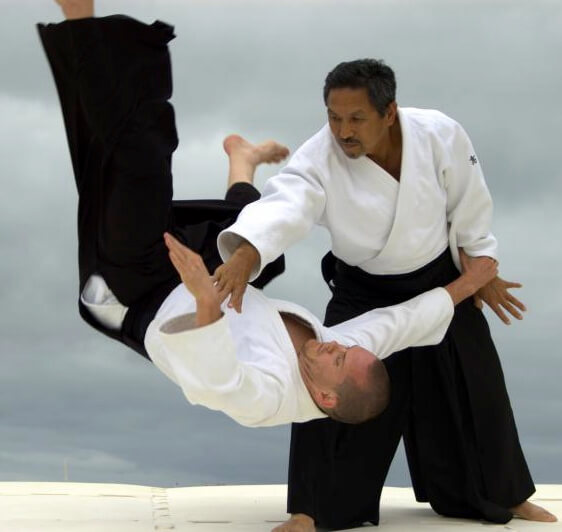The awesomeness of Aikido

VIDEO: WOAH! See this insane fight jiu jutsu vs aikido! Find out who wins.
Each movement was not only fluid, but it clearly demonstrated the raw power generated by proper body movement from the center. Throughout his movements, O-Sensei was completely in balance, and in control. As a result, he could easily control the movements of each uke (attacker). My first Aikido instructor was Rod Kobayashi Sensei, 6th Dan, who really emphasized the dropping of the hip to disturb the balance of uke.
Rather than ‘techniques’, I prefer the concept of ‘shapes’. This is an attempt to escape from the form. But that is not to suggest that form be avoided – for beginners it is essential. For beginners the form is a necessary introduction to any martial art, no less so in Aikido. With a little experience under one’s belt, good basics, good ukemi, a few gradings, and a lot of kokyu-nage, one will have become quite familiar with the basic patterns of Aikido. The emphasis here is on ‘patterns’. Now, it will become helpful to regard the techniques as shapes. Thus we have ikkyo shape, nikyo shape, or kaiten-nage shape. This is to help one come to terms with the vast number of variations that exist.
Aikidoka, perhaps more than most other martial artists, often hold courses where a mixture of styles meet. Often, they frequent other dojos on friendly visits. It is while participating in these kinds of activities that confusion can set in for the unwary. What results is a classification of styles, or dojos – we do it this way, they do it that, another dojo does it another, apparently creating different sets of what is essentially the same knowledge. The key to learning Aikido is to look for the commonalties, not the differences, since it is only in the common principles where solid foundations lie. At first, it is not easy to spot common principles as they are not always so obvious to the uninitiated; one needs a discerning eye. And even amongst the differences one may find other hidden principles just waiting to be grasped. For example, a difference at another school might indeed be a very good principle that one’s own school lacks. It is also the case that some of these differences are bad. But one must be careful – it may be that the problem lies in one’s own method, not theirs. Honest retrospection is the key through which the answers will emerge.
There are many ikkyo shapes. If one can make a particular ikkyo shape work, it makes sense to adopt it in one’s repertoire. If one can not make it work, but others can, then the problem obviously lies in the self. Suspect the technique last. More often than not, the differences between variations seem just mechanical. A different foot is forward or a different entry is used. However, if one had just a mechanistic view of the techniques there would be no end to the number of variations to remember. And this is the way many people train. That different entry is not a mechanical difference but represents a new principle that could be applied elsewhere, in other ‘shapes’. By thinking about it and trying to make that new entry fit into another ‘shape’, one will automatically assign it as a useful principle. One need not remember that particular ikkyo variation, just remember the new principle so that it helps to create one’s own new personal variations. Of course, they will not really be new, nor one’s own, as others have already discovered them a thousand times before, but there is nothing better than to discover, to feel in control of one’s learning experience, and not be completely dependent upon a teacher. This is where the voyage of real discovery begins and may explain what is meant by the assertion – the Shodan is just a beginner. The Shodan has the tools and should have all the pieces, so now must set to work putting them together and figuring out what it all means. But there is no need to wait until Shodan to begin: When meeting in vigorous practice one has little time to think. What happens is, one meets uke, recognises a shape such as ikkyo or kaiten-nage, and takes it. One way to practice this is for uke and tori to run and clash into each other, gently-ish. At the moment of random clash, both pause, tori looks at uke and examines the situation trying to recognise a shape. Once tori recognises something, it is used and technique materialises.
After one has a grasp of what principles are and can collect and apply them to one’s own aiki, then, and only then, will one be able to look at what others are doing and say with certainty that, “That is correct,” or, “That is wrong.” In the long run, it will help distinguish sound technique from bad variation. Many times I have seen people criticise good form. It may not be good form in a certain school, but it is good form nevertheless, which indicates that they do not know. Naturally perhaps, it is the tradition in martial arts that when visiting other schools one does it their way; the purpose in visiting another school is to learn new ways, not show your own. Certainly, when visiting other schools the wise look for new principles, not new form.
According to Stenudd.com, Ikkyo “is the most basic of all aikido techniques, and should be possible to do on any attack. It is also an entrance move for nikyo, sankyo, yonkyo, gokyo and hijikime osae”.




